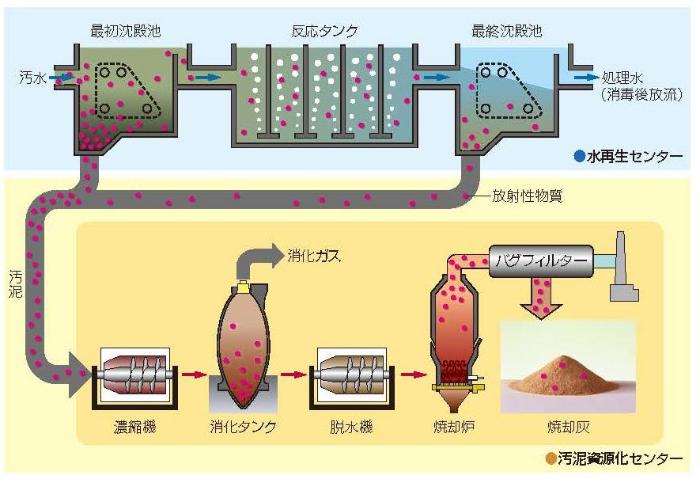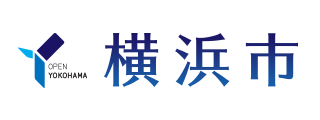- Yokohama-shi Top Page
- Living and Procedures
- Community Development and Environment
- Rivers and sewers
- Sewer
- Disaster prevention and disaster countermeasures
- Radioactive material concentration in sewage sludge
Here's the text.
Radioactive material concentration in sewage sludge
Last Updated December 24, 2024
Reason for the inclusion of radioactive materials in sewage sludge incineration ash
The radioactive material diffused following the accident at the Tokyo Electric Power Company, Incorporated Fukushima Daiichi Nuclear Power Station reaches Yokohama City due to atmospheric flow, flows into sewer pipes due to rain, etc., and reaches the Water Reclamation Center. Sewage is treated at the Water Reclamation Center and the Sludge Recycling Center, and eventually becomes sewage sludge incineration ash. As mentioned above, radioactive materials flowed into the sewer pipes, so sewage sludge incineration ash also contained radioactive materials.

History of Sewage sludge incineration ash
September 9, 2011 Announced landfill at Minamihonmoku landfill
- Safety confirmation of landfill of sewage sludge incineration ash → Landfill announced on or after September 15
September 14, 2011 Freeze landfill at Minamihonmoku landfill
- Since the explanation was insufficient to the people concerned, the landfill was "freeze" until sufficient explanation was given.
- We explained to citizens and related parties using materials that explained the contents of the "Safety Evaluation Study Report on Landfill of Sewage Sludge Incinerated Ash at Management Type Disposal Site" in an easy-to-understand manner. .
We proposed future correspondence plan of sewage sludge incineration ash in September, 2013 and explained to citizen, related people. .
- About past process of sewage sludge incineration ash and future correspondence (plan) (PDF: 1,327KB)
July 2014 In addition to the improvement to date as a Hijiwara fee, recycling as a construction material began.
Dec. 2014 Dec. 2014 The Company decided to reclaim incinerated ash from April 2014 onwards in the land area of Minamihonmoku landfill.
From February to March 2015, a mixed ash mixture of Resources and Waste Recycling Bureau's main ash and sewage sludge incineration ash was carried out at the Minamihonmoku Waste landfill.
July 2015 Landfill commenced in the same way as reclamation.
September 2017 Completed landfill at the Minamihonmoku Waste landfill.
Current Continued disposal through improved soil and resources as construction materials.
Radioactive material concentration in sewage sludge
Radioactive material concentrations in dewatered sludge, sludge incineration ash, and improved soil are as follows.
| Name | Hokubu Sludge Treatment Plant | Nambu Sludge Treatment Plant | ||||
|---|---|---|---|---|---|---|
Dewatered sludge | Sludge incinerated ash | Improved soil | Dewatered sludge | Sludge incinerated ash | ||
| Date of sampling | 2024 | 2024 November 25 | 2024 | 2024 November 5 | 2024 | |
| Cesium-134 | Non-detection | Non-detection | Non-detection | Non-detection | Non-detection | |
| Cesium-137 | Non-detection | 32.0 | Non-detection | Non-detection | 48.1 | |
※Non-detection indicates that the detection limit is below the detection limit.
※We started measuring iodine-131 as an index to confirm the effects of the nuclear accident, but based on the fact that the half-life of iodine-131 has already passed three years or more, September 2014 From 1st, there are two items, cesium-134 and cesium-137, excluding the measurement items.
- Past Radioactive Material Concentration Data (~ End of August 2014) PDF(PDF:82KB) excel (Excel: 145KB)
- Past Radioactive Material Concentration Data (September 2014 to mid-June 2014) PDF(PDF:712KB) excel (Excel: 57KB)
- Past Radioactive Material Concentration Data (from late June 2020) PDF(PDF:561KB) excel (Excel: 134KB)
Sludge incinerated ash is stored in the northern and Nambu Sludge Treatment Plant sites.
Changes in storage status of incinerated ash and concentration of radioactive materials
- The current and past storage status of sewage sludge incineration ash is as follows.
Storage status of sewage sludge incineration ash (PDF: 618KB)
The storage status of sewage sludge incineration ash was nearly 38,000 tons in the south and Hokubu Sludge Treatment Plant at its peak, but the disposal has gradually decreased. However, the situation has to be placed in the hall, which affects the operation of the facility.
On the other hand, the concentration of radioactive materials incinerated ash in sewage sludge has been reduced to less than one-tenth of the level compared to the beginning of storage.
- The spatial radiation dose rate at the site boundary is as follows.
| Name | East side | West | South side | North side | Date of measurement |
|---|---|---|---|---|---|
| Hokubu Sludge Treatment Plant (Suehiro-cho, Tsurumi-ku) | 0.05 | 0.05 | 0.05 | 0.04 | 2024 |
| Nambu Sludge Treatment Plant (Koura, Kanazawa-ku) | 0.05 | 0.05 | 0.05 | 0.05 | 2024 |
※Measurement at a point 1 meter high from the ground
- Past space radiation dose rate data PDF(PDF:182KB) excel (Excel: 19KB)
Other radioactive material concentrations
- Inflow sewage and discharge water
- Radioactive substance concentration in exhaust gas
- Radioactive material concentration data of Minamihonmoku landfill mixed ash PDF (PDF: 63KB) excel (Excel: 50KB)
(The landfill disposal ended in September 2017)
Materials, etc.
- Safety evaluation study book (PDF: 473KB) about disposal of sludge incineration ash including radioactive material
- Explanatory materials on the handling of sludge incineration ash, etc. containing radioactive materials (Color version) (PDF: 6,692KB) (black and white version) (PDF:9,013KB)
※"Figure 3-4 Radiation Exposure around People" on page 20 of this explanatory document has been updated with the data from the source. For more information, please refer to the following URL.
http://jccu.coop/food-safety/qa/pdf/qa03_03_02.pdf (external site)
You may need a separate PDF reader to open a PDF file.
If you do not have it, you can download it free of charge from Adobe.
![]() To download Adobe Acrobat Reader DC
To download Adobe Acrobat Reader DC
Inquiries to this page
Sewer River Bureau Sewerage Facilities Department Facility Management Section
Telephone: 045-671-3965・3966
Telephone: 045-671-3965・3966
Fax: 045-641-4870
Email address: gk-shisetsukanri@city.yokohama.jp
Page ID: 681-048-429







